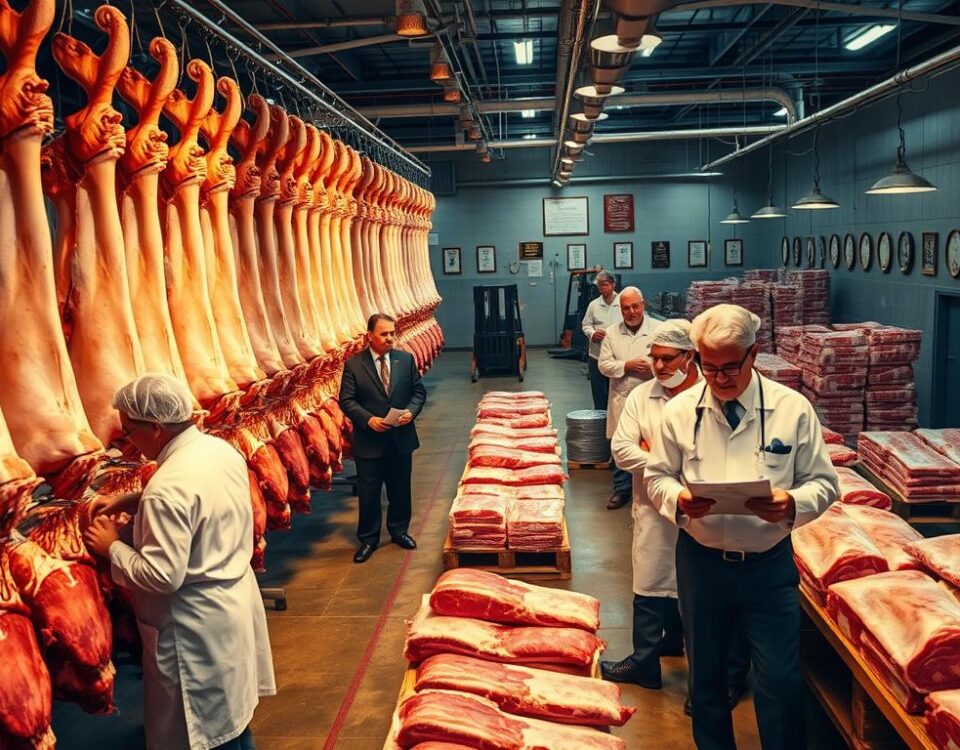
The Best Commercial Grill Setup for Maximizing Sales
September 8, 2025
6 Hidden Secrets Behind Jackson vs Hobart Cleaning Performance
September 9, 2025As a kitchen manager or chef, you understand the importance of a reliable dishwasher in the heart of your kitchen operations. I recall a busy restaurant that struggled with an inefficient dishwasher, resulting in delayed service and frustrated staff. Did you know that a commercial dishwasher can run for up to 16 hours a day in a busy kitchen, making it a crucial investment for your establishment?
Choosing the right dishwasher can significantly impact your kitchen’s workflow, staff productivity, and even your utility bills. With so many options available, it’s essential to make an informed decision when selecting a commercial dishwasher for your kitchen.
That’s why I’ve put together this comprehensive buying guide to help you navigate the complex world of commercial dishwashers and find the perfect match for your specific needs.
Key Takeaways
- Understand the different types of commercial dishwashers available
- Learn about the key features to consider when selecting a dishwasher
- Discover how to optimize your kitchen’s workflow with the right dishwasher
- Find out how to reduce utility bills with an energy-efficient dishwasher
- Get tips on maintaining your commercial dishwasher for longevity
Understanding Commercial Dishwashers
A commercial dishwasher is more than just an appliance; it’s a critical piece of equipment in any kitchen. Commercial dishwashers are designed to handle the heavy demands of a busy restaurant or food service environment, providing a fast and efficient way to clean and sanitize large quantities of dishes, utensils, and cookware.
What Makes Commercial Dishwashers Different
Commercial dishwashers differ significantly from their residential counterparts in terms of power, speed, and sanitization capabilities. They are built to withstand the rigors of continuous operation and are designed to meet strict food safety regulations, heating water to temperatures between 149-160°F for washing and at least 180°F for the final sanitizing rinse.
| Feature | Commercial Dishwashers | Residential Dishwashers |
|---|---|---|
| Wash Cycle Time | 2-3 minutes | 30+ minutes |
| Wash Temperature | 149-160°F | Typically lower |
| Sanitizing Rinse Temperature | At least 180°F | Often not available |
Why Your Kitchen Needs the Right Dishwasher
The right commercial dishwasher serves as the heart of your kitchen operations, ensuring a constant supply of clean dishes, utensils, and cookware during busy service periods. By investing in the appropriate dishwasher for your kitchen needs, you can improve workflow efficiency, reduce labor costs, and ensure consistent sanitation standards, ultimately helping your restaurant meet food safety compliance regulations.
When selecting a dishwasher, it’s essential to consider the specific needs of your kitchen, including the volume of dishes to be washed, available space, and desired features such as energy efficiency and noise level.
Types of Commercial Dishwashers
The world of commercial dishwashers is diverse, offering a range of models to suit different needs. As a key component in any commercial kitchen, selecting the right dishwasher is crucial for efficiency, hygiene, and cost-effectiveness.
Undercounter Dishwashers
Undercounter dishwashers are compact powerhouses perfect for smaller establishments like cafes and bars. They fit neatly beneath countertops while still offering professional cleaning capabilities.

Door-Type Dishwashers
Door-type dishwashers represent the middle ground in commercial dishwashing, offering higher capacity than undercounter models without requiring the space of conveyor systems. They are ideal for medium-sized restaurants.

Conveyor Dishwashers
Conveyor dishwashers are the workhorses of large-volume operations, allowing for continuous loading and unloading of dish racks. Some models can process up to 400 racks per hour, making them indispensable for high-volume kitchens.

Glass Washers
Glass washers are specialized machines designed specifically for cleaning delicate glassware. They use gentler wash actions and specialized racks to prevent breakage while ensuring sparkling results.

Pot and Pan Washers
Pot and pan washers feature powerful spray jets and larger washing chambers to tackle heavily soiled cookware that wouldn’t fit or get clean in standard commercial dishwashers.

Understanding the differences between these types of commercial dishwashers will help you match the right machine to your specific kitchen needs, volume requirements, and space constraints.
High-Temperature vs. Low-Temperature Dishwashers
High-temperature and low-temperature dishwashers cater to different needs in commercial kitchens, each with its own set of advantages. The choice between these two types of commercial dishwashers depends on several factors, including the type of cuisine, energy efficiency, and sanitization requirements.

Benefits of High-Temperature Washing
High-temperature dishwashers use water at temperatures between 150°F and 180°F to sanitize dishes, effectively killing bacteria and viruses. The benefits of high-temperature washing include faster drying times and better removal of greasy residues. According to industry experts, “High-temperature dishwashing is particularly effective for kitchens that handle a lot of greasy food, as it provides a more thorough cleaning.” This method also potentially lowers chemical costs over time, as it relies less on chemical sanitizers.
However, high-temperature systems typically require ventilation hoods and more energy to maintain the elevated water temperatures, which can increase both installation and operational costs.
Advantages of Low-Temperature Systems
On the other hand, low-temperature dishwashers operate at temperatures between 120°F and 140°F and rely on chemical sanitizers to achieve proper sanitation. The advantages of low-temperature systems include lower energy costs and reduced steam in the dishwashing area. Additionally, low-temperature dishwashers do not require ventilation hoods in most cases, making them a more flexible option for commercial kitchens.
A comparison of the two systems is summarized in the table below:
| Feature | High-Temperature Dishwashers | Low-Temperature Dishwashers |
|---|---|---|
| Operating Temperature | 150°F – 180°F | 120°F – 140°F |
| Sanitization Method | Heat | Chemical Sanitizers |
| Energy Consumption | Higher | Lower |
Ultimately, the choice between high-temperature and low-temperature dishwashers will depend on your specific needs, including your menu, budget considerations, available space for ventilation, and environmental priorities.
Key Features to Consider in Your Commercial Dishwasher Buying Guide
When selecting a commercial dishwasher, several key features must be considered to ensure optimal performance. As a buyer, you need to evaluate various factors to make an informed decision.
Cleaning Capacity and Speed
Cleaning capacity and speed are crucial considerations when choosing a commercial dishwasher. You’ll need to match your dishwasher’s throughput, measured in racks per hour, to your establishment’s volume. Options range from 30 racks per hour for undercounter models to 400+ for high-capacity conveyor systems.
Water and Energy Efficiency
Water and energy efficiency features can significantly impact your utility bills. Energy Star certified models use up to 40% less water and electricity than standard models, potentially saving thousands of dollars annually. When evaluating dishwashers, look for those with advanced efficiency features.
| Feature | Standard Model | Energy Star Certified |
|---|---|---|
| Water Usage | High | Up to 40% less |
| Energy Consumption | High | Up to 40% less |
Sanitization Capabilities
Proper sanitization capabilities are non-negotiable for food safety compliance. Commercial dishwashers need to reach at least 160°F during washing and 180°F during the final rinse to meet FDA requirements. Ensure your chosen dishwasher can achieve these temperatures.
Noise Levels and Durability
Noise levels and durability should also factor into your decision. A quieter machine improves the working environment, while robust construction ensures longevity in demanding kitchen conditions. Consider these aspects when selecting your commercial dishwasher.
By carefully evaluating these key features, you can find the ideal dishwasher for your commercial needs, ensuring efficient and effective cleaning.
Sizing Your Commercial Dishwasher
Sizing your commercial dishwasher correctly is vital for optimizing your restaurant’s operations. The right size ensures that you can efficiently handle your dishwashing needs without wasting resources.
Assessing Your Restaurant’s Volume Needs
To determine the correct size, start by assessing your restaurant’s volume needs. Calculate your peak dishwashing demands by considering the number of meals served during your busiest period, the number of dishes used per customer, and how quickly you need to turn tables. For instance, a standard dish rack holds about 20 plates. So, if your restaurant serves 100 meals during peak hours, you might need to wash 5-10 racks per hour, depending on the dishes used.
Different types of dishwashers offer varying capacities. Undercounter models can handle 30-35 racks per hour, while door-type dishwashers can process 40-75 racks hourly. Conveyor systems, on the other hand, can manage 200-400 racks per hour. I recommend adding a 20% buffer to your calculated capacity needs to account for unexpected busy periods and future growth.

Space Considerations and Installation Requirements
Space considerations are equally important when sizing your commercial dishwasher. Measure not just the footprint of the dishwasher but also allow for loading/unloading areas, dish storage, and proper ventilation. Installation requirements vary between models, with high-temperature systems typically requiring ventilation hoods. All commercial dishwashers need appropriate water supply, drainage, and electrical connections.
By carefully assessing your restaurant’s volume needs and considering the space and installation requirements, you can choose a commercial dishwasher that fits your kitchen’s layout and operational demands. This ensures a smooth workflow and efficient dishwashing process, ultimately contributing to the success of your restaurant.
Top Commercial Dishwasher Brands
In the world of commercial dishwashers, certain brands have established themselves as leaders in terms of performance and customer satisfaction.
I’ve researched the leading commercial dishwasher manufacturers to help you identify brands known for reliability, performance, and value.
Hobart Commercial Dishwashers
Hobart is known for durable and efficient dishwashers built for busy restaurants. The Hobart CDL-1, for example, can process up to 51 racks an hour.

Champion Commercial Dishwashers
Champion dishwashers stand out for their innovative designs and user-friendly features. They offer a wide range of models to suit different kitchen sizes and needs.

Jackson Commercial Dishwashers
Jackson focuses on performance and reliability in its commercial dishwashers. Built for high-volume operations, Jackson dishwashers offer fast cycle times and thorough cleaning.

CMA Dishmachines
CMA Dishmachines specializes in compact, high-efficiency dishwashers ideal for smaller kitchens.

Blakeslee Commercial Dishwashers
Blakeslee has pioneered the commercial dishwasher industry since 1880, inventing the first mechanical dishwasher. Their models are known for heavy-duty construction and specialized solutions.

Each brand offers distinct advantages in terms of price point, specialized features, and after-sales support, so I recommend considering which factors matter most for your specific restaurant operation.
Understanding Commercial Dishwasher Costs
When investing in a commercial dishwasher, understanding the total cost of ownership is crucial. This includes not only the initial purchase price but also long-term operating expenses.
Initial Investment
The initial purchase price of a commercial dishwasher can vary widely based on the type and features. For instance, a compact glass washer might cost under $3,000, while a high-end undercounter model could cost upwards of $9,000. Larger capacity dishwashers, such as conveyor or door-type models, typically start around $10,000, with top-of-the-line systems exceeding $40,000.
| Type of Dishwasher | Price Range |
|---|---|
| Compact Glass Washer | $2,000 – $3,000 |
| Undercounter Model | $3,000 – $9,000 |
| Conveyor/Door-Type | $10,000 – $40,000+ |
Ongoing Expenses
Long-term operating costs include utilities (water and electricity), chemicals (detergents, rinse aids, and sanitizers), maintenance, and potential repair expenses. Energy-efficient models, such as those with an Energy Star certification, can save thousands in utility costs over their lifespan.
“Energy Star certified dishwashers typically use 40% less water and energy than standard models,” which can lead to significant savings.
Financing Your Dishwasher
Many restaurant equipment suppliers offer financing options, including equipment leasing, which allows you to preserve capital while still acquiring the necessary dishwasher with predictable monthly payments.
Key Considerations: When calculating the total cost of ownership, factor in labor savings from more efficient dishwashers, as faster cycles mean less staff time dedicated to dishwashing.

Maintenance Requirements for Commercial Dishwashers
To keep your commercial dishwasher running efficiently, regular maintenance is key. Proper maintenance not only extends the lifespan of your dishwasher but also ensures it continues to clean effectively. In this section, we’ll explore the essential maintenance tasks required to keep your commercial dishwasher in top condition.
Daily Cleaning Procedures
Daily cleaning is crucial for maintaining your commercial dishwasher. This includes removing and cleaning the strainer baskets, wiping down wash arms to clear any clogs, checking and refilling chemical dispensers, and running an empty sanitizing cycle at the end of service. By doing so, you prevent the buildup of debris and ensure your dishwasher continues to operate effectively.
Key daily tasks include:
- Cleaning strainer baskets
- Wiping down wash arms
- Checking and refilling chemical dispensers
- Running an empty sanitizing cycle
Deliming and Descaling
Deliming and descaling are critical maintenance tasks, especially in areas with hard water. Mineral deposits can clog spray jets, reduce heating efficiency, and eventually damage your dishwasher if left untreated. I recommend using a commercial-grade deliming solution every 1-3 months, depending on your water hardness and usage volume. Always follow the manufacturer’s specific instructions for your dishwasher model.
| Maintenance Task | Frequency | Importance |
|---|---|---|
| Daily Cleaning | Daily | High |
| Deliming/Descaling | Every 1-3 months | High |
| Professional Service | As needed | High |
When to Call for Professional Service
While daily cleaning and regular deliming can prevent many issues, there are times when professional service is necessary. Unusual noises, leaks, inconsistent water temperature, poor cleaning results, or error codes on digital displays all warrant professional attention. Establishing a regular maintenance schedule and training staff on proper daily cleaning procedures will significantly reduce downtime and repair costs.
By following these maintenance guidelines, you can extend the useful life of your commercial dishwasher and ensure it continues to perform optimally.
Water Quality Considerations
Water quality is a critical factor in the performance and longevity of commercial dishwashers. I’ve found that it’s one of the most overlooked factors when purchasing and maintaining dishwashers, yet it can dramatically impact performance and equipment lifespan.
Impact of Hard Water
Hard water contains high levels of minerals like calcium and magnesium that can leave spots on glassware, create scale buildup inside your dishwasher, and reduce the effectiveness of detergents. Over time, scale buildup from hard water can clog spray jets, reduce heating efficiency, damage heating elements, and even lead to complete system failure if not properly addressed.
Solutions for Water Quality Issues
Testing your water hardness is a simple first step – many equipment suppliers offer free testing, or you can purchase inexpensive test kits to determine if you need water treatment solutions. Water softening solutions range from built-in water softeners in some dishwasher models to external water softening systems that treat water before it enters your dishwasher.
| Water Hardness Level | Recommended Solution | Benefits |
|---|---|---|
| Soft | None | Minimal risk of scale buildup |
| Moderate | Built-in water softener | Reduces scale buildup, improves detergent efficiency |
| Hard | External water softening system | Protects equipment, reduces maintenance needs |
For restaurants in areas with extremely hard water, a dedicated water softening system is often the most cost-effective long-term solution, protecting not just your dishwasher but all water-using equipment. Even with water softening systems in place, regular deliming procedures remain important for maintaining optimal dishwasher performance and extending equipment life.
Energy Efficiency and Sustainability
When it comes to commercial dishwashers, energy efficiency is not just a virtue, but a necessity for reducing operational costs. As a key component of a restaurant’s operations, commercial dishwashers require significant amounts of water and energy to function effectively.
Energy Star Ratings Explained
One way to ensure your commercial dishwasher is energy-efficient is by looking for models with Energy Star certifications. These dishwashers use approximately 40% less energy and water than standard models, which can translate to significant savings on utility bills. The Energy Star certification process involves rigorous testing of both water consumption and energy usage. When evaluating Energy Star dishwashers, pay attention to the gallons-per-rack specification, which indicates the machine’s efficiency.
- Energy Star rated commercial dishwashers can save hundreds or even thousands of dollars annually on utility bills.
- The initial premium for energy-efficient models typically pays for itself within 1-2 years through utility savings.
Water Conservation Features
Modern commercial dishwashers incorporate various water conservation features to reduce water consumption. These include advanced rinse arm designs, recirculating wash systems, and soil sensors that adjust cycle length based on the dirtiness of the dishes. Some high-efficiency commercial dishwashers also incorporate heat recovery systems that capture steam and heat from drain water to preheat incoming cold water, significantly reducing energy consumption.
By investing in an energy-efficient commercial dishwasher, you not only reduce your environmental footprint but also lower your operational costs. It’s a smart long-term investment for environmentally conscious restaurants.
Making the Final Decision: Matching the Dishwasher to Your Needs
To make an informed decision, you must align your restaurant’s needs with the capabilities of the commercial dishwasher you’re considering. This involves a careful assessment of your daily operations, space constraints, and budget.
Balancing Budget with Requirements
When choosing a commercial dishwasher, it’s essential to balance your budget with your requirements. Consider the total cost of ownership, not just the initial purchase price. A more expensive but efficient dishwasher might save you money in the long run through reduced utility and labor costs. Here are some key factors to consider:
- Create a prioritized list of your non-negotiable requirements based on your restaurant’s volume, space constraints, and specific washing needs.
- Don’t compromise on features that directly impact your daily operations, such as adequate capacity for peak periods and appropriate cycle options for your specific dishware.
Future-Proofing Your Purchase
Future-proofing your purchase means selecting a dishwasher that can accommodate your restaurant’s growth over the next 5-10 years. Consider whether you anticipate increasing customer volume or menu changes that might affect dishwashing needs. Look for dishwashers with modular designs that allow for upgrades or modifications as your needs change.
Before making your final decision, speak with other restaurant owners using the models you’re considering and, if possible, arrange a demonstration to see the dishwasher in action. Remember, the right dishwasher for your restaurant is one that reliably meets your specific needs, not necessarily the most expensive or feature-rich model on the market.
Conclusion
In conclusion, selecting the ideal commercial dishwasher is a crucial decision for any food service establishment. This comprehensive guide has covered all the essential aspects to consider when choosing a dishwasher that meets your specific needs.
By understanding the different types of dishwashers available, considering factors like cleaning capacity, energy efficiency, and maintenance requirements, you can make an informed decision that impacts your daily operations, staff efficiency, and bottom line.
Remember, the perfect dishwasher for your kitchen balances capacity needs, space constraints, budget considerations, and long-term operational costs. With the right commercial dishwasher in place, your kitchen will operate more efficiently, and your customers will enjoy consistently clean tableware.
FAQ
What type of dishwasher is best for my restaurant?
The best type of dishwasher for your restaurant depends on the volume of dishes you need to clean, the available space, and your budget. I recommend considering undercounter, door-type, or conveyor dishwashers based on your specific needs.
How do I determine the right size of dishwasher for my kitchen?
To determine the right size, assess your restaurant’s volume needs by calculating the number of dishes you need to clean per hour. Also, consider the space available for the dishwasher and any installation requirements.
What are the benefits of high-temperature washing?
High-temperature washing provides superior sanitization and can be more effective at removing grease and food residue. However, it may require more energy and can be harsher on dishes.
How can I reduce my dishwasher’s energy and water consumption?
Look for dishwashers with Energy Star ratings and water conservation features. I also recommend implementing regular maintenance, such as deliming and descaling, to ensure your dishwasher operates efficiently.
What maintenance is required for my commercial dishwasher?
Daily cleaning procedures, deliming and descaling, and regular professional service are essential to maintaining your dishwasher’s performance and extending its lifespan.
How does hard water affect my dishwasher?
Hard water can cause scaling and lime buildup in your dishwasher, reducing its efficiency and potentially damaging the machine. I recommend considering water softening solutions to mitigate this issue.
What are the advantages of conveyor dishwashers?
Conveyor dishwashers are ideal for high-volume kitchens, as they can handle a large number of dishes quickly and efficiently. They often feature multiple wash and rinse cycles, ensuring thorough cleaning and sanitization.
Can I finance my commercial dishwasher purchase?
Yes, many manufacturers and suppliers offer financing options for commercial dishwashers. I recommend exploring these options and considering factors like interest rates and repayment terms when making your decision.



